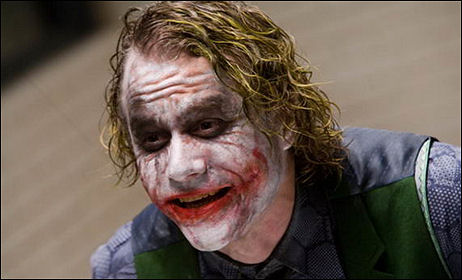In the view of two knowledgable guys interviewed by AP reporter David Germain, Heath Ledger‘s death will — sadly, ironically — be a kind of boon to the fortunes of The Dark Knight (Warner Bros., 7.18). Germain states that Chris Nolan‘s film “has already emerged as arguably the biggest movie featuring a posthumous role in Hollywood history.”

Everyone is tiring of seeing this same old Heath/Joker photo over and over — it would be nice if Warner Bros. would remedy this.
Bill Ramey, founder of the fansite Batman-on-Film.com, says that “more people will come to see [Knight] because of Ledger’s death. No doubt some people may be apprehensive about seeing it because there may be a little ghoulish factor about it. But I’m betting that more people now kind of look at it as a tribute to him, and the biggest tribute you could give someone is to go see it and enjoy his performance.”
Ball State University film professor Wes Gehring says “it’s a tacky thing to say, but what would have been a negative in the past now could be a positive thing. I think we’ve done a flip-flop on pop culture. Now it might actually be a selling point for a movie where you say, ‘So and so’s dead. Let’s go see his movie.’ What might have been a hindrance in 1935 now won’t be a problem.”
The list of major actors who starred in films after their deaths includes (1) James Dean (both Rebel Without a Cause and Giant opened after his car-crash death in September 1955), (2) Clark Gable (The Misfits came out 75 days after his passing on 11.16.60)), (3) Carole Lombard (To Be or Not To Be opened two months after her plane-crash demise), (4) Spencer Tracy (Guess Who’s Coming to Dinner arrived in December ’67, six months after Tracy’s death on 6.10.67), (5) Jean Harlow (Saratoga opened six weeks after her death on 6.7.37), (6) Robert Walker (My Son John came out in April 1952, 9 months after his death in August ’51), and (7) Montgomery Clift (whose final film, The Defector, came out in mid-November 1966, about five months after his death in July of that year.)
